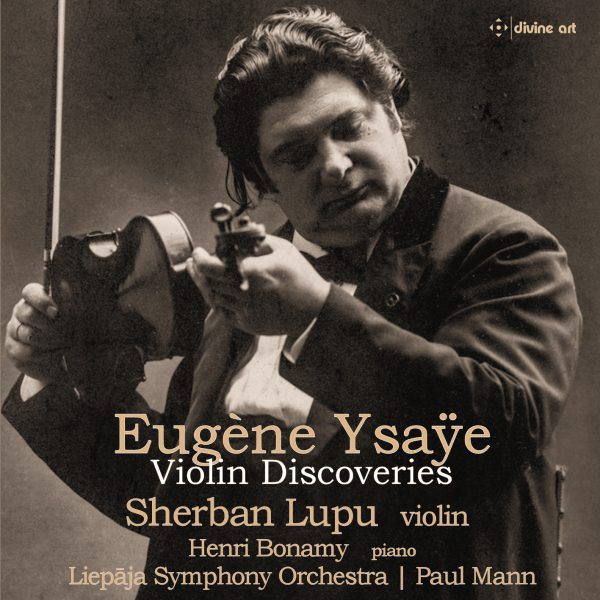Fanfare
Romanian violinist Sherban Lupu possesses both the technique and the musicality to make this disc, titled Eugene Ysaÿe: Violin Discoveries, a success. It is an important addition to the discography of the famous Belgian violin virtuoso and composer, because everything here is a premiere recording except for the five-minute Petite fantaisie romantique. The disc is complemented by very thorough program notes by Qianyi Fan, a student of Lupu’s.
Although everything on the program ranks as a discovery, the major news is the Violin Concerto in G Minor. The score is actually a reconstruction by Lupu, with orchestration by Sabin Pautza, a Romanian composer and conductor. The story of its origins is complex but well told in the notes. Ysaÿe made a number of attempts to complete this concerto, the final one in 1910, which is written out in a piano score. There are some pages of orchestration from earlier versions, which served as the basis of Pautza’s edition.
Whatever its tangled history, this is a significant addition to the repertoire of late Romantic-era violin concertos. It is as attractive, and a bit less predictable, as anything I’ve encountered by Wieniawski or Vieuxtemps, both of whom were Ysaÿe’s teachers. The concerto is in one continuous movement, with a variety of moods and tempos. It features soaring lyricism alongside virtuosic passages of double-stops that require complete control of the bow. Lupu plays beautifully, integrating the flashy moments into the whole. Recognizing the shortcomings of a verbal description, I would say that the idiom is a mixture of Romanticism and Impressionism. The Liepaja Symphony Orchestra from Latvia under Paul Mann accompanies Lupu with sensitivity and a sense of involvement. This work would make a more welcomed addition to the repertoire than yet another performance of Tchaikovsky, Brahms, Mendelssohn, and Bruch.
This release is the result of research done by Lupu, who was a pupil of one of Ysaÿe’s favorite students, Joseph Gingold. Inspired by Gingold’s stories about Ysaÿe, Lupu began searching for archived manuscripts, concentrating on the libraries in Brussels and Liege. In the library of the Royal Conservatoire of Liege he was directed to a massive stack of Ysaÿe manuscripts, which Lupu describes as being about “12 feet long and three feet high.” The music recorded here was all discovered during that research project.
The Scènes sentimentales were composed in 1885, about the time that Ysaÿe decided to embark on a career as a soloist, giving up his position in a prominent Berlin beer-hall orchestra (it later evolved into the Berlin Philharmonic). At the age of 27 Ysaÿe the composer was still finding his individual voice; the two scenes chosen by Lupu are attractively lyrical and demonstrate a strong melodic gift.
Elégie was an incomplete score, lacking either a title or an ending. Lupu has provided both. As testimony to the composer’s growth, there is a darkness and harmonic adventurousness in the music, which was probably composed in 1912, that documents the composer’s growth.
The Trois études-poèmes were separate works that Ysaÿe brought together and intended to publish as a set in 1924. The second poème, “Au ruisseau,” consists almost exclusively of double-stops, but they serve a musical purpose and not merely a showy one. The third piece, “Cara memoria,’’ is the most impressive. At almost 12 minutes it is twice as long as the first two combined and constitutes true chamber music, with the piano part being much more than an accompaniment. The sound world is very French, exhibiting a bittersweet quality that is quite touching. From the Liege Conservatory trove, the Petite fantaisie romantique has a posthumous dedication from the composer’s son Antoine to Gingold in 1967: “You are such a wonderful pupil of Ysaÿe and a witness of his legacy, so you should enjoy this piece.” Such a tender miniature would make a lovely encore piece for any violinist. Lupu plays throughout with the necessary bravura but, more importantly, with the necessary elegance and poetry. Henri Bonamy is a sensitive pianist who interacts well with the violinist. The recorded sound is very well balanced. Anyone interested in the literature of the violin from this era is likely to be delighted to discover these additions to what we already know about Ysaÿe as a composer.
@divineartrecordingsgroup
A First Inversion Company
Registered Office:
176-178 Pontefract Road, Cudworth, Barnsley S72 8BE
+44 1226 596703
Fort Worth, TX 76110
+1.682.233.4978











![Listen to the full suite of Marcel Dupré’s Variations Sur un Noël, Op. 20 from Alexander Ffinch’s #Expectations release today! listn.fm/expectations [in bio]](https://scontent-dfw5-1.cdninstagram.com/v/t51.71878-15/588904367_2327488161082898_8709236950834211856_n.jpg?stp=dst-jpg_e35_tt6&_nc_cat=105&ccb=7-5&_nc_sid=18de74&efg=eyJlZmdfdGFnIjoiQ0xJUFMuYmVzdF9pbWFnZV91cmxnZW4uQzMifQ%3D%3D&_nc_ohc=H3rHeRayPTgQ7kNvwEDfdJP&_nc_oc=AdkgPslGh_0VtlDEzbk0WsrpYdpJyfX8V7LRt6dXR2AO0PIx5seGP10TVmK0ZlkVBU0&_nc_zt=23&_nc_ht=scontent-dfw5-1.cdninstagram.com&edm=ANo9K5cEAAAA&_nc_gid=P0a7W6Rsi63D4TyXEW7Ncg&oh=00_AfkioVBDtVKlKwWKoKSBQRq1b4d2JriHD3XMUIUQPYLOpw&oe=695A76EA)
